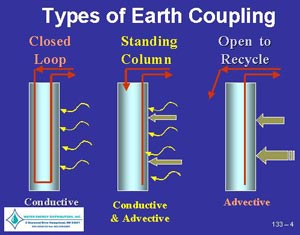Geothermal System Basics
Learn About Geothermal Systems
Geothermal heating and cooling is more than just a great way to save money, it’s a great way to save the planet too. It’s safe, easy to maintain, eco-friendly, and dependable. Geothermal Energy is not a new technology, and the concept is as old as the Earth. The technology is definitely interesting, and there’s a lot to know! We’ve put together resources to help you learn:
 The Geo Glossary will help with those technical terms.
The Geo Glossary will help with those technical terms.- Visit the Workroom for cost calculators & finance information.
- Review our case studies to get a visual.
- Attend the Homeowner’s Workshop to learn more.
Water Energy wants you to know the facts about Geothermal Energy so that you can make an informed decision. If you need more information, or you’re ready to take the first step in starting your project, contact us!
Geothermal Systems Explained
Wondering what makes geothermal systems so efficient? Or how systems are designed to meet the exact needs of your home? These two videos with Martin Orio will give you a better understanding of how residential geothermal systems work.
THE BASICS
There are three earth-coupling methods are most commonly employed throughout the geothermal industry: closed loop, standing column, open to recycle. All three options take advantage of the virtually limitless renewable energy that the earth provides. These three methods have advantages and disadvantages, which are discussed below.
To best understand these options first consider the general approach to taking energy from OR returning energy to the earth. During the winter months, we extract stored solar energy that resides in the earth. Approximately 50% of the solar energy that strikes the earth is stored in the waters of the earth. In the summer the relatively cool earth serves as a convenient sink for the excess energy from our homes and buildings.
VARIANTS & STANDARDS
As geothermal heat pump application grows each of the following generalized methods have developed variants. These methods are available through the established Heating Ventilating & Air Conditioning (HVAC) infrastructure in the US and internationally. The International Standards Organization (ISO) has taken responsibility to evaluate geothermal heat pumps in its “standard ISO 13256”. Previously, the Air conditioning & Refrigeration Institute ( ARI), in the USA, had that responsibility. Today, ISO and ARI are overlapping with ISO taking the lead.
ABOUT THE THREE METHODS
Closed Loop Systems
These systems are either horizontal or vertical (as shown) and depend upon an antifreeze solution exchanging energy from the average New England earth. At temperatures of 50°F in winter, a cold 30°F return solution will make the earth energy flow towards the wellbore (CONDUCTIVE FLOW), warming the solution. The opposite energy flow occurs in the summer.
Standing Columns
Similar to Closed Loop Systems, Standing Column Systems take advantage of conductive heat transfer, but also augment their energy transfer capability by simply moving small amounts of stable earth temperature(50°F) water – this process is called “ADVECTIVE” flow. This stable temperature water is, typically located only 40-50 feet away from the bore.
Open to Re-circulation
This earth coupling method simply takes advantage of stable groundwater temperatures within rock fractures or porous earth, and depend solely upon an ADVECTIVE flow into the borehole. High yield wells and a responsible method of returning the water to the earth is required. This method is also known as a “doublet” earth coupling.
Comparison of Methods
The following is a general comparison of each of the three geothermal earth coupling options under several criteria. Keep in mind that these are generalizations, and each method must be evaluated for the application and location of the installation.
